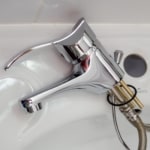Is Your Faucet Spinning? (Causes & Simple Solutions)
This post will tell you what to do when a faucet spins and you no longer can turn on or off the water.
Also, we shed light on the reasons why this happens and how you can avoid this problem in the future.
Contents
Handle of your fitting spins
Mixing faucets with two rotary knobs, one for hot and one for cold water, are particularly popular in bathrooms.
However, it is annoying when the knob just keeps turning without any water coming out. This can of course also happen with faucets with just one handle.
And it is even more annoying when the water suddenly cannot be turned off any longer.
The Cause
To understand the cause for this, you have to look at the structure of mixer faucets with rotary knobs: What is usually only visible as the handle of the mixer faucet actually consists of three parts:
- A cap
- A plastic locking sleeve
- A valve
In order for the water to be turned on and off, all three parts must interlock.
Most of the time it is a damaged locking sleeve that wears out and causes it to spin.
Maybe someone turned the knob too tightly and damaged the plastic parts.
Or the locking sleeve has worn so heavily over time that it can no longer find any grip inside the handle.
The good thing: Anyone who knows the manufacturer of their faucet or the appropriate dimensions can easily get a replacement.
Locking sleeves and complete handles are available just a few Dollars. And doing the replacement is not rocket science either:
The repair
The following steps are necessary to repair a mixer faucet with a spinning handle:
1. Interrupt the water supply
The first thing you need to do is turn off the water supply. One way to do this is via the corner valves, which are usually located on the left and right side under the sink.
Since these are never turned in many households, it is often difficult to close them.
Try some pipelayer pliers, but don’t use too much force so as not to tear off the piece.
If, in spite of your best efforts, the corner valves cannot be turned, you can alternatively close the main shutoff valve for your apartment.
2. Prepare the replacement
Once the water supply is interrupted, open the (still working) second knob to allow pressure and residual water to escape.
As a precaution, you should cover the sink with a towel so that the locking sleeve does not accidentally slip into the drain when it is screwed off.
3. Remove the handle
Now take the rotary knob off. For some models, it is sufficient to simply pull hard on them as they are only slipped on.
Most of the time, however, a cap is attached to the top of the rotary knob.
If you carefully pry it open with a screwdriver, a screw will appear. Loosen that screw. Then remove the rotary knob from the valve attachment.
4. Replace the locking sleeve
The locking sleeve is located inside the knob. It can be removed without tools and replaced with a new part.
Of course, you can also equip your faucet with a new knob right away. This is the more sustainable solution, especially if the knobs are worn.
Here is a short video that shows how quickly and easily the locking sleeve can be changed:
5. Replace valve (optional)
Of course, the problem may not be caused by the knob but the valve.
This has small metal gears that attach to the locking sleeve. If these are so worn that they no longer have any grip, you can unscrew the old valve with an open-ended spanner and replace it with a new one.
The cost of a cheap valve is around 4 dollars. The water should then be easy to turn on and off again using the rotary knob.
Water connection faucet (corner valve) spins
The problem of spinning handles is also a common problem with stopcocks. These angle valves regulate the water supply for:
- Wash basins
- Sinks
- Washing machines and dishwashers
If, for example, the faucet on the washing machine spins, the supply can no longer be controlled.
At the latest when you want to install a new appliance, you have to turn off the water. So sooner or later a replacement may become necessary.
The Cause
Angle valves usually lead a neglected existence and are not turned for years.
If someone suddenly closes the angle valve – for example when connecting a new appliance – there is a good chance that it will no longer work afterwards.
Preventive measures (avoid spinning)
In order to avoid such damage in advance, it helps to turn the stopcocks regularly.
Opening and closing them once a month is sufficient to ensure that the valves can move freely.
The repair
Once the damage has occurred and the angle valve rotates uncontrollably, the only solution is replacing it.
Conventional models must be sealed with hemp or Teflon tape before installation. If you want to save yourself this work, you should use a self-sealing valve.
Proceed as follows:
1. Interrupt the water supply
Before you can start the replacement, you have to turn off the water, of course.
In the case of corner valves for sinks and household appliances, this is done via the main shut-off valve. This is usually located in the basement before the water meter.
2. Remove the old valve
Unscrew the fitting connection and remove the water hose. Then unscrew the old angle valve with suitable pliers. Be careful not to tear the valve holder out of the wall.
3. Installation of the new valve
Screw in the new valve after sealing it with hemp or Teflon tape. This step is not necessary with self-sealing valves.
Use the pliers for the final turns. Again, be careful not to use too much force. Screw the water hose back on.
4. Functional test
Now it’s “water on”.
It is best to ask a second person to turn on the main shut-off valve while you check the new angle valve for leaks.
If water leaks, your helper can turn it off again immediately.
In this short video you can see the steps just described:
Main shut-off valve spins
As this post has shown, the water must be turned off before any repairs on any of the faucets to avoid damage.
But what happens if the main shut-off valve (before the water meter) spins and the water can no longer be turned off for the entire apartment?
In this case, all you can do is call the water company, as they are responsible for maintaining the central shut-off valve.
Homeowners are allowed to close, but not change it. The good thing: in the event of a defect, the water company must pay the full costs.
Sharing is caring 🙂 !
[addtoany]




